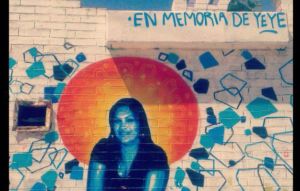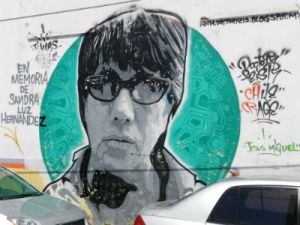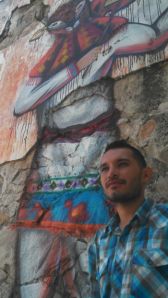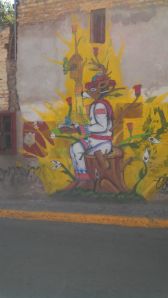This article was first published in RíoDoce on 22 June 2014. It has been translated without permission for the Mexican Journalism Translation Project (MxJTP).
Urban Muralists Treat City as Canvas
By Javier Valdez Cárdenas (RíoDoce)
The walls speak. They shout.
The strokes, the colors, the silhouettes on the outsides of the old houses, low joists, on the fences of abandoned properties: they catch eyes, trap stares, and when the observer stops a moment, stays in front of the graffiti, the stencil, the aerosol, the acrylic, there are reflections and conversations, dreams and feelings.
Fingerprints of the new and old asphalt artists touch Andrade or Obregón avenues, the walls of the new promenade, historic downtown’s old buildings, the city’s police boxes, and Buelna or Rosales streets. They mark space, express their own resistance or that of those they represent, criticize, protest, and leave their mark.
Doctor Feis is one of these rebels. He seems to antagonize the untouched walls and the plain whites of some façades. On one wall he painted the face of Genoveva Rogers, nicknamed Yeye, the paramedic killed by gunshots when armed men ran after a man – he fled into the Red Cross – and a bullet killed the young woman.
Her face was painted on the wall of an abandoned police box, rescued by youth movement Recuperarte in the 10 de Mayo neighborhood. They are spray can murals and Doctor Feis has exhibited his work in states like Oaxaca, Baja California, Mexico City, Puebla, Querétaro, and Baja California Sur.
“To paint walls was mere fancy, custom. But then it became a hobby, and now it’s become a way for me to express myself,” says the 26-year old youth, originally from the capital city of Culiacán, a graduate of the Autonomous University of Sinaloa’s art school.
On Andrade Avenue, between Ángel Flores and Rosales Streets, on the so-called Paseo del Ángel he painted the face of Sandra Luz Hernández, the activist shot to death in May while looking for her son Edgar Guadalupe, missing since February 2012.
In Yeye’s case, he did it out of friendship. He knew her family. It was a way to keep her memory alive and celebrate the arc of her life. But Sandra Luz’s murder pained him: the impunity, the violence that has smothered and stuck to Sinaloa’s society, where silence, surrender, and indifference rule in the empire of bad things, where people order killings and put their fingers on the trigger, ready to shoot.
Doctor Feis explains that he first painted commonplaces, but now he wants to express social concerns, nourishing collective memory: the deaths of three musician friends in Lomas del Bulevar, the disappearance and murder of one more friend in La Primavera – these are facts that mark his outlines, the colors, the blood, and the anger – of his street murals.
“There, on the walls, it’s transcendent. It stays. In newspapers, it’s a momentary thing. Like what happened to Genoveva, then with Sandra Luz. Things happen and everybody forgets. You can play protest songs in the Cathedral every day, but the song sticks with you after it is played. The mural remains. That’s why I put one on the Paseo del Ángel, a place of entertainment, so that it disrupts things, generates something,” he says.
Wrong Steps
Early in the morning, while the city sleeps and the patrol cars howl and luxury trucks whine, the wall warriors take to the shadows to write the city’s history – its disasters and dreams – on a canvas of brick, limestone, and cement. The Watchavato, maybe the most famous artist of Culiacán’s tarmac, paints with a stencil technique, signing like a dog pissing on posts and corners.
One of those giant dollars was placed on Obregón and Madero a few weeks ago: “Infinite thanks” read the sign, and in its center, an effigy of Jesús Malverde. A few days later, in a spunky show of censorship, city police destroyed the paper sculpture. Now you can just see its disfigured remains.
There, on walls shrouded in darkness, brushes shout, spray cans swear, ink cries, dripping down walls that are overcome by time, limestone and dust. Hooded they come brandishing their hardware, then the officers in their patrol cars, some more than others up early, drunk, drifters. Nothing’s going on, we are working, they respond and don’t want to be provoked or challenged. Occasionally they work in groups, bring cameras and lights to see or to improve the looks of the blows and paint strokes. Like cats in heat, some work alone: caterwauling over the fence, a wall, a cement canvas, making the city shout what its citizens have shut up about and what the government covers up.
To Resist
He calls himself Diske One. That’s his name. From Culiacán, 24 years old, time spent living with the mountain folk of Sinaloa and Durango. Down and out, nothing more, among the Huicholes and Tepehuanes, Mayos and Yoremes, documenting them, learning from them, understanding them, embracing that life, why they do things, their long-term marginalization.
One of his works, maybe his most imposing and unsettling, is on Rafael Buelna Street in front of the Sinaloan Art Museum (Masin): it’s of a red Huichol, decked out, deer head, spilled paint, playing a violin on his left shoulder, on a scarred canvas, bare bricks, half-eaten walls, hands up in surrender.
He says that as a child the panhandlers frightened him. That fear stayed with him through his teenage years and as a challenge his father used to hand him coins to give to the indigenous people and beggars. When they saw he had money, they danced for him. Now he doesn’t fear them, he admires them. He paints them, follows their struggle and their marches, and does the same with the Huicholes and other indigenous communities.
“Each time I finish painting them, I’m still busy. There’s so much about them to paint: like the fight of the Huicholes in Wirikuta, where they want to build a mine that the indigenous people oppose. They won’t be able to do that to them. They are very unified, not like us. They have power, beliefs. They resist and say, ‘go fuck yourselves.’ That’s what I am telling people with my work: they resist, they exist, they are here,” he says.
This type of expressions on the city’s walls, he adds, represents a cry of criticism, or protest, of social and collective reflection, about what’s happening in Sinaloa and the rest of the country.
“Artists have a social commitment to the people’s problems, their hopes and dreams, their needs and worries. We have to renew ourselves, too. To look for new ways forms of expression, to find new techniques and themes, to keep on creating,” he emphasized.
In Culiacán’s different corners are at least five of his works, all some sort of mural, using a spray can and acrylic paint. They express the destruction of the environment, indigenous people that fight against marginalization and injustice, to keep on going and resist.
And maybe with these lines, colors, and silhouettes they will stop the fences from being quiet, the city from staying silent, and crumbling.
Journalist Javier Valdez Cárdenas is the founding editor of RíoDoce, an online news outlet based in Culiacán, Sinaloa. He is the author of various books, including Con la Granada en la Boca (Aguilar, 2014). This article was first published under the title, “Toman muralistas urbano ciudad como lienzo,” and is available at: http://riodoce.mx/noticias/toman-muralistas-urbanos-la-ciudad-como-lienzo.
Translator Patrick Timmons is a human rights investigator and journalist. He edits the Mexican Journalism Translation Project (MxJTP), a quality selection of Spanish-language journalism about Latin America rendered into English. Follow him on Twitter @patricktimmons. The MxJTP has a FaceBook page: like it, here.




[…] June 24, 2014 — “Artists have a social commitment with people’s problems, their hopes and dreams, their needs and worries. We have to renew ourselves, too. To look for new ways forms of expression, to find new techniques and themes, to keep on creating.” […]